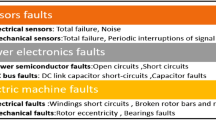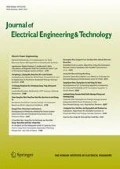Abstract
This paper presents the development and experimental verification of the mathematical model of wind turbine and Doubly Fed Induction Generator (DFIG) using the current control and voltage estimation method between the DC link. The rotor of the induction generator (IG) is rotated with the wind turbine at a specific speed. The DFIG is directly coupled with a grid station and the synchronization between DFIG and the grid station is controlled by setting two converters: Machine Side Converter (MSC) implemented with the rotor side and Grid Side Converter (GSC) implemented with the grid. PI controllers have been utilized in the control loops and the parametric range is extracted to maximize the mechanical power transferred to the IG rotor. The model is tested under three conditions DFIG running at super synchronous speed, synchronous speed, and under synchronous speed using MATLAB Simulink. In the end, the same model is also tested through a series of experiments using lab modules. The results show that the proposed model is much simplified and accurate as compared to previous versions available in the literature.






















Similar content being viewed by others

Abbreviations
- \(A\) :
-
Turbine swept area
- \(\beta\) :
-
Blade Pitch angle
- \({\uppsi }_{\mathrm{r}}\) :
-
Rotor side flux
- \({\uppsi }_{\mathrm{s}}\) :
-
Stator side Flux
- \({C}_{P}\) :
-
Performance factor
- \({C}_{p}\) :
-
Power coefficient
- DFIG:
-
Doubly fed induction generator
- DSL:
-
Dynamic simulation language
- \({E}_{wind}\) :
-
Wind energy
- GSC:
-
Grid Side converter
- H :
-
Motor inertia
- IG:
-
Induction generator
- \({i}_{\mathrm{s}}\) :
-
Stator current
- \({i}_{r}\) :
-
Rotor current
- \({I}_{abc}\) :
-
Three phase line current
- \({L}_{m}\) :
-
Mutual inductance
- \({L}_{r}\) :
-
Rotor side inductance
- \({L}_{s}\) :
-
Stator side inductance
- \(\lambda\) :
-
Tip speed ratio
- \({P}_{g}\) :
-
Grid active power
- \(P\) :
-
Number of poles
- \({P}_{m}\) :
-
Mechanical power
- \({Q}_{g}\) :
-
Grid reactive power
- \({R}_{r}\) :
-
Rotor resistance
- \({R}_{s}\) :
-
Stator resistance
- \({T}_{e}\) :
-
Induced torque
- \({T}_{m}\) :
-
Mechanical torque
- \({V}_{DC}\) :
-
DC voltage
- \({V}_{abc}\) :
-
Three phase line voltage
- \({V}_{r}\) :
-
Rotor side voltage
- \({V}_{s}\) :
-
Stator side voltage
- \({V}_{wind}\) :
-
Wind velocity
- \({\theta }_{e}\) :
-
Synchronously rotating angle
- \({\omega }_{r}\) :
-
Rotor angular velocity (rev/min)
- \({\omega }_{s}\) :
-
Synchronous speed (rev/min
- \(\mathrm{MSC}\) :
-
Machine side converter
- \(\mathrm{NREL}\) :
-
National Renewable Energy Laboratory
- \(\mathrm{t}\) :
-
Time
- \(\mathrm{THD}\) :
-
Total harmonic distortion
References
U. S. E. (2013) Supply, 20% wind energy by 2030. Increasing wind energy’s contribution TO U.S. electricity supply. Wind power: technology, economics and policies, pp 99–333. GO-102008–2567.
Luiz Lacerda Ferreira Murari A, Alberto Torrico Altuna J, Vani Jacomini R, Mario Rocha Osorio C, Sebastian Solis Chaves J, Joaozinho Sgaurezi Filho A (2017) A Proposal of Project of PI controller gains used on the Control of Doubly-Fed Induction Generators. In: IEEE Latin America Transactions, vol. 15, no. 2, pp 173–180. https://doi.org/10.1109/TLA.2017.7854609
Meshcheryakov VN, Muravyev AA, Boikov AI (2018) Induction generator based on doubly-fed machine. In: 2018 17th International Ural Conference on AC Electric Drives (ACED), no. 1, pp 1–5. https://doi.org/10.1109/ACED.2018.8341719
Sousa GCD, Martins FN, Sousa GCD, Martins FN (2015) An autonomous fuzzy controlled induction generator system with voltage regulation velocity-based dynamic model and adaptive controller for differential steered mobile robot view project optimizing robot controller gains with Genetic Algorithm View project, 2004. https://doi.org/10.13140/RG.2.1.4837.2328
Müller S, Deicke M, De Doncker RW (2002) Doubly fed induction generator systems for wind turbines. IEEE Ind Appl Mag 8(3):26–33. https://doi.org/10.1109/2943.999610
Ma J, Zhao D, Yao L, Qian M, Yamashita K, Zhu L (2018) Analysis on application of a current-source based DFIG wind generator model. CSEE Journal of Power and Energy Systems 4(3):352–361. https://doi.org/10.17775/cseejpes.2018.00060
Asgari SH, Jannati M, Idris NRN (2014) Modeling of three-phase induction motor with two stator phases open-circuit. In: 2014 IEEE Conference on Energy Conversion (CENCON), pp 231–236, https://doi.org/10.1109/CENCON.2014.6967507
Shah S, Rashid A, Bhatti MKL (2012) Direct quadrate (d-q) modeling of 3-phase induction motor using matlab/simulink. Can J Electr Electron Eng 3(5):237–243
Zhang D, Wang Y, Hu J, Ma S, He Q, Guo Q (2016) Impacts of PLL on the DFIG-based WTG’s electromechanical response under transient conditions: analysis and modeling. CSEE J Power Energy Syst 2(2):30–39. https://doi.org/10.17775/cseejpes.2016.00019
Zhang Y, Muljadi E, Kosterev D, Singh M (2015) Wind power plant model validation using synchrophasor measurements at the point of interconnection. IEEE Trans Sustain Energy 6(3):984–992. https://doi.org/10.1109/TSTE.2014.2343794
Goksu O, Altin M, Fortmann J, Sorensen PE (2016) Field validation of IEC 61400–27-1 wind generation type 3 model with plant power factor controller. IEEE Trans Energy Convers 31(3):1170–1178. https://doi.org/10.1109/TEC.2016.2540006
V. W. Group (2015) Value and limitations of the positive sequence generic models of 2.0. The value of the generic model structures
Xu M, Gu T, Xu J, Wang K, Li G, Guo F (2018) Electromechanical modeling of the direct-driven wind turbine generator considering the stochastic component of wind speed. In: 2018 2nd IEEE Conference on Energy Internet and Energy System Integration (EI2), no. 1, pp 1–4. https://doi.org/10.1109/EI2.2018.8582114
Dadhania A, Venkatesh B, Nassif AB, Sood VK Modeling of doubly fed induction generators for distribution system power flow analysis. Int J Electr Power Energy Syst 53(1):576–583. https://doi.org/10.1016/j.ijepes.2013.05.025
Khajuria S, Kaur J (2012) Implementation of pitch control of wind turbine using simulink (Matlab), vol. 1, no. 4, pp 196–200
Ong C-M (1998) Dynamic simulation of electric machinery, 1st edn. Prentice Hall, London, pp 141–155
Berhanu Tuka M, Leidhold R, Mamo M (2017) Modeling and control of a doubly fed induction generator using a back-to-back converters in grid tied wind power system. In: 2017 IEEE PES PowerAfrica, pp 75–80. https://doi.org/10.1109/PowerAfrica.2017.7991202
Swami Naidu NK, Singh B (2015) Doubly fed induction generator for wind energy conversion systems with integrated active filter capabilities. In: IEEE transactions on industrial informatics, vol. 11, no. 4, pp 923–933. https://doi.org/10.1109/TII.2015.2446767
Sharma S, Singh B (2011) Voltage and frequency control of asynchronous generator for stand-alone wind power generation. IET Power Electron 4(7):816. https://doi.org/10.1049/iet-pel.2011.0007
Li S, Haskew TA (2007) Analysis of decoupled d-q vector control in DFIG back-to-back PWM converter. In: 2007 IEEE power engineering society general meeting, pp. 1–7. https://doi.org/10.1109/PES.2007.385461
Hughes TA (2015) Measurement and control basics. In: Measurement and control basics, 5th ed., International Society Automation, p. 409
Acknowledgements
The authors would like to thank to colleagues for suggestions to improve the paper quality.
Author information
Authors and Affiliations
Corresponding author
Additional information
Publisher's Note
Springer Nature remains neutral with regard to jurisdictional claims in published maps and institutional affiliations.
Rights and permissions
About this article
Cite this article
Ahmad, H., Khalid, H., Amin, A. et al. Improved Current Controlled Doubly Fed Induction Generator Model with Grid Integration Under Sub and Super Synchronous Conditions. J. Electr. Eng. Technol. 16, 141–153 (2021). https://doi.org/10.1007/s42835-020-00572-w
Received:
Revised:
Accepted:
Published:
Issue Date:
DOI: https://doi.org/10.1007/s42835-020-00572-w



